-
Saturday Morning MARACOOS OceansMap Hurricane Figure Contest Winner
Posted on July 25th, 2020 No commentsIts close enough to noon that we can declare Doug Wilson’s – from Ocean and Coastal Observing – Virgin Islands (OCO-VI) – contribution the winning hurricane figure of the morning. It is a figure produced from MARACOOS OceansMap that plots the sea surface temperature from the Navy Global Ocean Forecast System (a HYCOM based model, hence the name in OceansMap, Navy HYCOM) in the Caribbean, with the temperatures enhanced to highlight the coastal upwelling along South America. The more southerly track of Gonzalo is going right over the colder water. Another important feature of the adjustable scales is that ability to highlight specific features, like that anticyclonic eddy south of Hispaniola that is not in MPIPOM. This is an area begging for an Argo float comparison. Something we can check into next week.
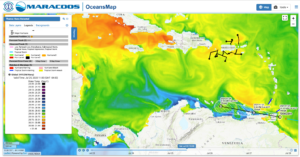
To not leave Hanna out of the mix, here is a similar plot for the Gulf of Mexico. Here I adjusted the temperature scale so that it ranges from 25 to 32. Our automated plots made overnight give us the ability to quickly browse for interesting subjects. Then OceansMap enables the deep dive. Again we have a story of coastal upwelling, both in front of Hanna, and very much along the Yucatan shelf. You can see the cold upwelled Yucatan shelf water being pulled north along the Loop Current. I wonder if images like this would help the NHC forecasts that have to define the edge of the Loop Current for the MPIPOM feature model initialization. Maybe we can talk to them more about how they do that. Another interesting feature is the Anticyclonic Eddy just north of Yucatan that was featured in the TS Cristobal blogs. You can see this eddy has continued to propagate westward since Cristobal crossed directly over it along 90W. Recall that this eddy is not in the MPIPOM model for Cristobal, since it needs to be inserted through the warm eddy feature model.
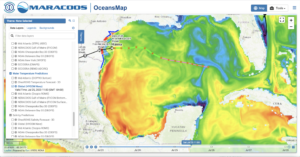
-
Hurricane Hanna
Posted on July 25th, 2020 No commentsHanna is forecast to become a hurricane today as it approaches landfall. Lets look at the ocean’s Sea Surface Temperature (SST) in the 3 global models beneath Hanna.
Keeping with the “It starts with us” tradition, here is the Navy Global Ocean Forecast System (GOFS 3.1). The track of Hanna is shown as the black line with the eye location dots approaching the Texas coast in the western Gulf. The SST is very warm, so warm it goes off of our standard scale and turns white for above 30C. In this region, forecasters often look to see if the surface temperature is above 26C for a quick assessment of how much the ocean supports intensification. Looks like it does. Hanna is currently over the warmest water, and that water cools down to the 28C range as it approaches shore. Note that the cooling down goes to 28C, which is still above the 26C diagnostic.
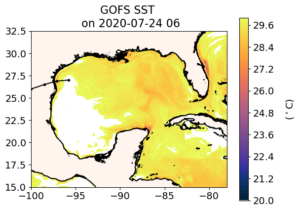
Now lets move to GOFS descendent RTOFS. Recall that RTOFS backs up two days into GOFS to get its initial conditions, giving up 2 days of data assimilation in favor of getting the NOAA global windfields over the ocean. The fields are nearly identical, with a slight shift of the over 30C water south along the Texas coast and east along the Yucatan coast. In this case, the warm water extending beyond our color bar turns into an unexpected benefit.
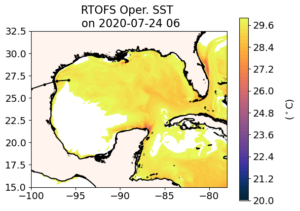
Now on to the European model. The western Gulf looks similar to GOFS – both are assimilating the same satellite SST data and SST dominates at the surface. Details differ, and offer room for investigation. But what really catches my eye is the western Caribbean where we see warming in the progression of models from GOFS to RTOFS to Copernicus. This area of the Caribbean between the Nicaraguan Bank and the Yucatan Strait between Mexico and Cuba is on the hurricane pathway into the Gulf of Mexico. The fresh water barrier layers we find so important east of the Nicaraguan Bank appear to be absent in this region.
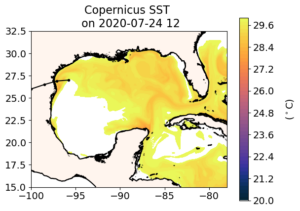
At some point I hope to add similar snapshots of the ocean under the operational hurricane models, the regional HMON and HWRF. HMON uses the regional HYCOM derived from RTOFS. It is the endpoint in the GOFS to ROTFS to HYCOM value chain. We can already imagine what the regional HYCOM will look like, similar to the models from which it is derived. But operational HWRF is coupled to MPIPOM which uses a different value chain to get its initial condition. So the critical step here is getting MPIPOM, but this still requires human intervention. Access to the global models is public, and is easily automated so our model/data comparisons run in the middle of the night while we sleep. The operational models are where they should be, protected behind the firewall. This is one reason why the ocean community is looking forward to the new, more open, Hurricane Analysis and Forecast System (HAFS). The first model scheduled to move into the HAFS environment is HWRF. Which ocean is coupled to the version of HWRF that will someday be in HAFS is of high interest.



